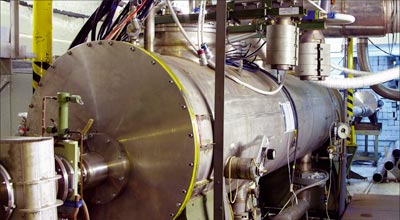
Image credit: IHEP.
The first superconducting high-frequency device made for particle physics has begun a new life at the U-70 proton synchrotron at the Institute for High Energy Physics (IHEP) at Protvino. It forms a key part of the new 200 m long high-intensity beam line for 12.5 GeV/c sup positively charged secondary particles, which was commissioned last December. With a content of 25% kaons the beam will be used in the OKA project, which will search for new physics in rare kaon decays. The high fraction of kaons in the beam is provided by the superconducting RF separator, the two niobium deflectors of which are cooled by liquid helium at a temperature of 1.8 K.
The separator was originally designed and constructed in 1970–1977 at the Institute für Kernphysik of the Kernforschungszentrum Karlsruhe, under the leadership of Herbert Lengeler of CERN. Until 1981 it was successfully used to provide a beam enriched in kaons and antiprotons for the Omega spectrometer at CERN. On completion of the experimental programme with the separated beam at Omega, the deflectors were stored at CERN under high vacuum for 17 years. Then, after vacuum-leak tests and other necessary preparations, the deflectors were transported from CERN to IHEP in 1998 (CERN Courier April 1998 p12).
Preparations for a new life for the deflectors began in 2006. First, comprehensive tests took place, together with the restoration of nominal working parameters of deflector RF2, which was damaged at CERN during preparation for the shipment to Russia. Then the two deflectors were placed 76.3 m apart on the beam line and connected to the cryogenic system, which has a refrigerating power of 250 W for superfluid helium at a temperature of 1.8 K. At the same time as the tests the group led by Boris Prosin designed and implemented an RF-feed and phasing system for the deflectors, based on modern microwave elements and the rubidium frequency-standard as a source of the signal. A set of power amplifiers and the common DC power supply, previously used in the antiproton cooling system at CERN, were connected to the output of the microwave system and a completely oil-free high-vacuum system was designed and arranged for each deflector.
Fridhelm Caspers from CERN and Axel Matheisen from DESY have provided important advice and practical help with some equipment for the preparation of the separator. Successful commissioning of the superconducting device was also substantially aided by the use of equipment remaining from a “warm” RF separator, which was developed at CERN 40 years ago for joint IHEP–CERN experiments at U-70 with the French bubble chamber “Mirabelle”. This separator had then been preserved in a very good condition at IHEP.
Stable working of the cryogenic system and the RF separator during the April run at U-70 provided the start of the data-taking at the OKA experimental facility for the study of rare kaon decays. Future efforts will aim to increase the intensity and quality of the separated beam and thereby ensure the success of the OKA experiment.







